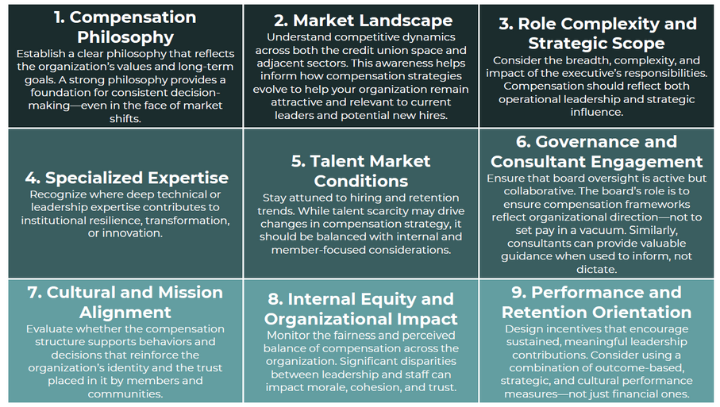4 minutes
Pay is not just a management tool—it’s a message to your credit union’s stakeholders.
While your board may have good intentions as it aims to reward performance and retain top talent, evidence suggests a growing misalignment between executive pay and the core outcomes credit unions are designed to deliver.
Effectively determining CEO compensation at your credit union requires more than referencing benchmarks and market data—it also requires accountability, knowing your organization’s values, and ensuring proper alignment of compensation with your mission and vision.
In this article, we’ll explore this data and what it tells us a bit more deeply, describe the ideal roles of the board and compensation consultants in this process, then dive into nine things you should consider when it comes to effective compensation for your top leaders—all with an eye on how setting compensation for your CEO is so important.
Executive Compensation Trends: What the Data Tells Us
2016 research shows that a trend we’ve been seeing is not new: Credit union CEO pay, particularly base and bonus compensation, is often more tightly linked to financial size and asset growth than to outcomes directly tied to member value or service quality. In the study , which analyzed Form 990 data, CEO compensation was found to increase with organizational growth, but not necessarily with improvements in member outcomes or organizational stewardship.
What’s more, the study noted that compensation consultants—when involved—significantly increased the likelihood that a CEO received a bonus. While this is a correlation rather than a direct cause, it suggests that engaging external advisors often leads to stronger alignment with prevailing market practices—many of which include performance-based incentives. This suggests that external guidance may sometimes tilt pay structures toward prevailing trends, even if those trends do not fully reflect the credit union’s values or service mission.
The Performance Disconnect
These patterns echo those seen in the for-profit sector, where pay is typically shaped around financial and operational benchmarks. While financial stability is critical, credit unions were not built solely to scale balance sheets. Boards must wrestle with an evolving challenge:
How do we ensure that executive compensation reflects both the health of the institution and its broader purpose?
Research from governance and nonprofit management literature has raised concerns that performance-based pay—when too narrowly defined—can shift executive focus away from long-term value creation and member impact. The result? Pay programs that reward organizational scale over organizational success.
The Role of the Board: Oversight, Not Ownership
Boards play a vital role in guiding and affirming compensation structures that align with the organization’s mission and values. That doesn’t mean boards should take on the role of compensation designers. Rather, they should focus on:
- Ensuring that the overall pay approach reflects the institution’s purpose
- Providing informed input into how performance is defined
- Reviewing consultant recommendations with an open mind, weighing them alongside culture, strategic direction, and member expectations
When done well, this kind of shared approach—where the board provides clarity, the consultant brings expertise, and the executive maintains operational alignment—can strike the right balance between market competitiveness and cooperative accountability.
9 Factors That Should Inform Executive Pay Decisions in Credit Unions
To design executive compensation that is both performance-minded and purpose-aligned, credit unions should consider the following:

Bridging the Gap: Compensation as a Strategic Signal
The compensation conversation in credit unions is shifting. All stakeholders—members, regulators, staff, and leadership—are paying closer attention to how executive pay reflects institutional values. As the industry evolves, so must our frameworks for rewarding leadership.
Boards and consultants should work together to ensure that pay programs reinforce what matters most: financial health, strategic clarity, and member-centered leadership. That requires openness to market data, thoughtful use of external guidance, and a willingness to define performance on more than just financial terms.
Final Thoughts
At its best, executive compensation is not just a management tool—it’s a message. A message to members about who leads their credit union, to employees about what is valued, and to communities about the institution’s priorities.
By designing compensation strategies that reflect both performance and purpose, credit unions can better position themselves for long-term success—and keep their leaders focused on what matters most.
JP O’Connor is a Senior Compensation Consultant at PARC Compensation Consulting, specializing in helping credit unions create compensation strategies that reward leadership performance, sustain long-term growth, and align with cooperative values.
PARC Compensation Consulting offers a full suite of executive compensation services designed to meet the unique needs of credit unions and non-profit organizations







